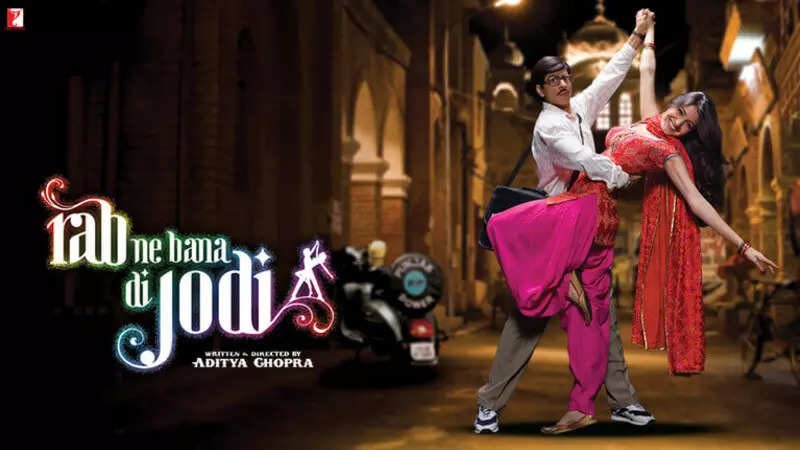
In the world of Indian cinema, symbolism and motifs are crucial for evoking deeper feelings in the audience. One such motif that has won over the hearts of millions of movie buffs over the years is the "Dancing Jodi," a term used to describe the famous dancing couple that appears throughout the movie "Rab Ne Bana Di Jodi." This motif pays homage to the illustrious Raj Kapoor logo, which was developed as a result of an emotional scene between Raj Kapoor and Nargis in the timeless movie "Barsaat" (1949). In this piece, we'll delve into the lengthy canon of the Dancing Jodi motif, look at where it first appeared in "Barsaat," and consider its significance in "Rab Ne Bana Di Jodi."
A heartwarming story of love, change, and self-discovery is told in the 2008 Bollywood blockbuster "Rab Ne Bana Di Jodi," which was directed by Aditya Chopra. Surinder Sahni, a mild-mannered and introverted man who falls in love with Taani, a character played by the vivacious Anushka Sharma, is the focus of the movie. Shah Rukh Khan plays him to perfection. As he lacks the charisma and self-assurance to seduce Taani, Surinder's love is unable to be expressed.
The Dancing Jodi motif becomes prominent in this setting. Surinder changes throughout the movie into the dapper and charming Raj, taking on a new persona to win Taani's heart. The motif depicts Surinder as a passionate and self-assured lover and serves as a visual representation of his inner transformation. As they navigate the ups and downs of life, the couple can be seen dancing together, capturing moments of love, joy, and togetherness.
The Dancing Jodi motif is a representation of the essence of love as it is expressed through movement, sound, and feeling. It connects with audiences across all languages and evokes sentiments of pure romance and nostalgia. This motif has come to represent the film's central idea, which is that love has the power to transform a person's circumstances dramatically.
In order to comprehend the origin of the Dancing Jodi motif, we must return to Raj Kapoor's "Barsaat" (1949), which was made during the height of Indian cinema. Raj Kapoor and Nargis gave outstanding performances in this classic movie that will live on in Bollywood history. A specific scene from "Barsaat" served as the inspiration for the iconic Raj Kapoor logo.
Raj Kapoor and Nargis are in this scene stranded in a violent downpour. They are wet and shivering, looking for shelter in a small hut. Raj Kapoor makes a show of chivalry and love by offering Nargis his coat as it pours down outside. The couple then performs a mesmerizing dance routine in the pouring rain, expressing their intense emotions through dance and song.
The audience was left with a lasting impression of this poignant scene, which was highlighted by the elegance of the dance, the purity of love, and the intensity of emotion. The Raj Kapoor logo, which features a dancing couple caught in the act of love and joy and frozen in time, was designed in response to this scene.
The stylized dancing couple in the Raj Kapoor logo quickly gained notoriety in Indian cinema. It served as a symbol of everlasting love and a lasting proof of the strength of feelings that cut across time and generational boundaries. The image became synonymous with Raj Kapoor's production company, R.K. Films, in addition to being used to adorn his movies.
Audiences responded strongly to the dancing couple in the Raj Kapoor logo, and it eventually came to represent the heart of romance in Bollywood. This enduring legacy has continued to have an impact on filmmakers and artists throughout the generations, including Aditya Chopra, the director of "Rab Ne Bana Di Jodi."
Aditya Chopra, who is renowned for his skill as a storyteller, was well aware of the emotional resonance and cultural significance of the Raj Kapoor logo. In "Rab Ne Bana Di Jodi," he cleverly used the Dancing Jodi motif to honor Raj Kapoor and his enduring contribution to Indian cinema.
In addition to honoring Raj Kapoor with this motif, Chopra gave the story more nuance and depth. Surinder's ability to dance with Taani, which is a tribute to the famous dance scene in "Barsaat," represents his transformation into Raj. In addition to a physical change, Surinder also experiences an emotional one as he gains the courage to express his love through dance, much like Raj Kapoor did in the soggy hut.
The "Rab Ne Bana Di Jodi" film's "Dancing Jodi" motif acts as a link between the heyday of Indian cinema and the current state of Bollywood. It honors the enduring strength of love and the capacity of art to communicate feelings that cut across time and space.
Inspired by the unforgettable rain dance sequence in "Barsaat" (1949), the Dancing Jodi motif in "Rab Ne Bana Di Jodi" is a lovely homage to the legendary Raj Kapoor and his iconic logo. This motif serves as a visual representation of the central theme of the movie and captures the essence of romance, love, and transformation. It conveys the idea that love has the capacity to cause significant changes in one's life through dance and emotion.
By including this motif, the movie gains depth and a deeper cultural resonance in addition to paying homage to Raj Kapoor's legacy. By serving as a bridge between the heyday of Indian cinema and the current Bollywood scene, it serves to remind us of the enduring power of love and the enduring allure of a beautiful dance. The motif of the Dancing Jodi in "Rab Ne Bana Di Jodi" is proof that some acts of love are truly eternal, just like the pictures that depict them.
Gabbar Strikes Gold, the ₹222.66 Cr Box Office Treasure